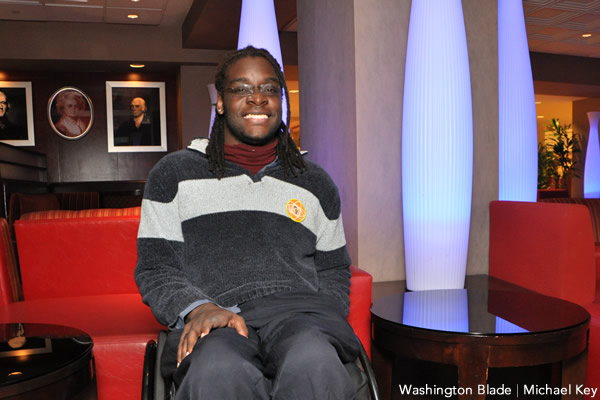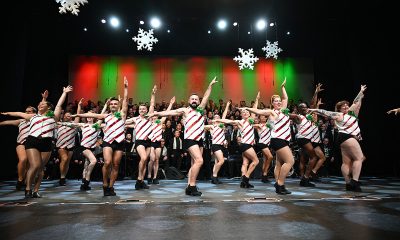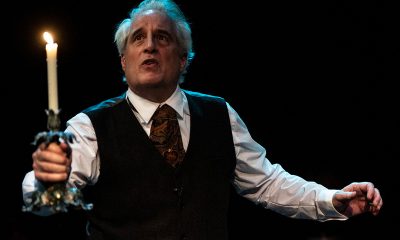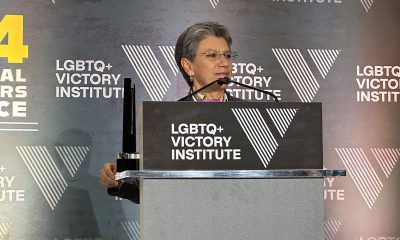Arts & Entertainment
Queery: D’Arcee Charington Neal
The Gay Men’s Chorus baritone answers 20 gay questions
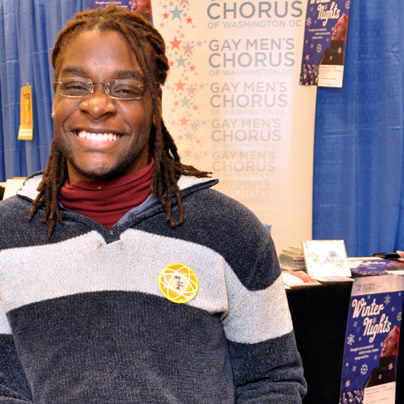
D’Arcee Charington Neal got in the Gay Men’s Chorus by the narrowest of margins.
A friend was auditioning back in August and Neal asked about it. Initially thinking he’d missed the deadline, he double checked the date and realized about 3 p.m. on the final day, he had until 5 to try out, so he did. He had never heard the Chorus or even realized there was such an outfit, but is enjoying his first season with the group. He sings baritone. Next weekend, the group gives three performances of its “Winter Nights” show at Lisner Auditorium (730 21st Street, NW; gmcw.org for details).
Neal is excited for the show.
“It will just be marvelous,” Neal says. “I’ve never really seen anything like it. … It’s everything from Bollywood to West African holiday music to traditional Latin choral arrangements.”
Neal, a 26-year-old Cary, N.C., native, came to Washington in 2007 for an internship. After completing a master’s degree (in creative and professional wiring) at London’s University of Roehampton, he returned to the District mostly because the Metro system makes it easy for him to get around.
“People in D.C. make fun of it, but they really have no idea,” he says. “From a disabled person’s perspective, it’s really the best thing in the U.S. I’ve ridden almost every underground in the country and D.C.’s is by far the best I’ve ever been on.”
Neal is single and lives in College Park, Md. He’s looking for writing work and says his disability has made finding employment difficult. He eventually wants to move into the District.
In his free time, he enjoys writing, cooking, singing and playing Call of Duty.
How long have you been out and who was the hardest person to tell?
I’ve been out since I was 17, and it was definitely my parents. My mother looked me in my face and said that she wished that I would have gotten AIDS and died so they could’ve mourned me and moved on already. That’s rough. But I know as older black people, they come from a different time. And as a disabled black person, they feel like I already have two strikes on my life, so they think being gay is something else I’m adding to make my life harder. (Editor’s note — Neal’s mother, Katherine Neal e-mailed the Blade and said she never said this.)
Who’s your LGBT hero?
Lady Gaga. Outside of being outrageously talented, I can’t think of anyone who genuinely works for the good of the gays and really believes in what they do, on her level. As a megastar she could be about anything, but she has taken this platform up, and I can’t thank her enough for it.
What’s Washington’s best nightspot, past or present?
I was a huge fan of club Apex. Coming from Bible Belt North Carolina, it was like this holy megaplex of debauchery. Multiple floors of thumping bass, and flashing lights, and all those shirtless men!
Describe your dream wedding.
Oh God, I’ve spent forever fantasizing about this. Probably in the courtyard of the Louvre Museum at night, candles everywhere standing in front of that glass pyramid, black and white roses scattered the ground. But my tux would be the star of the show. People don’t seem to understand that when you’re in a wheelchair you never get to be passionate about clothes, because half the time you can’t show them off! I’d want a three foot white silk train on the back of my coat draped down behind my chair in between the wheels and a matching fedora with a veil attached over my face. It’d be the most fabulous thing since J-Lo’s “The Dress.”
What non-LGBT issue are you most passionate about?
Without a doubt, disability acceptance in America. For the life of me, I cannot understand why disabled unemployment is at 75 percent, compared to the national average of 7.9 percent. … It feels like as a country, America is choosing to leave us behind. My parents fought to make sure I had a good education, and graduating from London in 2011, with my master’s degree, I felt like they did a great job. But the reality is, I’ve been unemployed for nearly two years, and while I’m waiting for the right opportunity, my disability makes employers believe I can’t work as a waiter, or in a grocery store or as a barista. And so I, like a lot of people, live off benefits, in an attempt to wait the economy out. And it’s not just me. This is the situation for lots of recent graduates with disabilities.
What historical outcome would you change?
I think I’d go back to the day Dr. Martin Luther King Jr. got shot and stop that. I honestly believe that a lot of the drama and the situations that Americans have been through since the end of Civil Rights (gangs, drugs, welfare, 9-11, education gaps, etc.) wouldn’t be half of what they are today.
What’s been the most memorable pop culture moment of your lifetime?
I think that would have to be when I sat in a room with Nikki Giovanni practically by myself and talked with her for half an hour. This woman embodies the last of everything my parents talk about in regards to American history, and she’s simply phenomenal in every way.
On what do you insist?
That there is no better food on earth than in the American Southeast.
What was your last Facebook post or Tweet?
Turducken is a deliciously grotesque mutation of God’s humblest creations.
If your life were a book, what would the title be?
“Life is Like a [Multifacted, Hypersensitive, Cracked, Racist, Overrated and Underappreciated] Box of Chocolates”
If science discovered a way to change sexual orientation, what would you do?
Read the fine print for the inevitably horrible side effects.
What do you believe in beyond the physical world?
Existence beyond emotions. An end to caring.
What’s your advice for LGBT movement leaders?
Consider all of your audience, and not just the popular section.
What would you walk across hot coals for?
Love. Someone who sees me a whole person, not in sections.
What LGBT stereotype annoys you most?
The idea that all gay men are weak and feminine. I’ve dated some men who could rip phonebooks in half, as well as a 2008 Olympian.
What’s your favorite LGBT movie?
“To Wong Foo, Thanks for Everything, Julie Newmar.” Noxzema is a chocolate goddess.
What’s the most overrated social custom?
Hugging. Being in a wheelchair, people are always so awkward about it. Either do it right, or don’t.
What trophy or prize do you most covet?
Probably my master’s degree from London. Considering what I had to do to get it, it definitely took the most work.
What do you wish you’d known at 18?
That I am not ugly or broken, and that not all men mean what they say.
Why Washington?
Two words: The Metro.
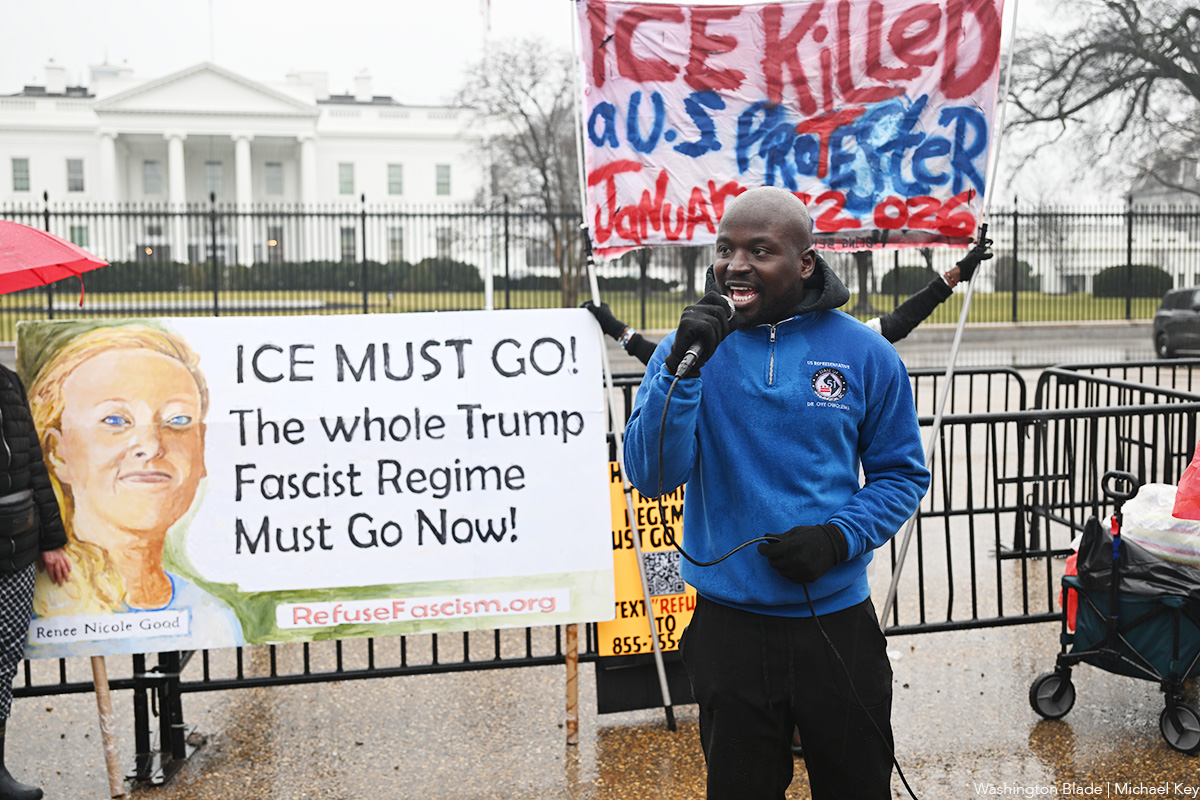
A protest was held outside of the White House on Saturday following the killing of Renee Nicole Good by a U.S. Immigration and Customs Enforcement agent in Minneapolis. Across the Potomac, picketers held signs calling for “Justice for Renee” in Tysons, Va.
Demonstrations were held in cities and towns across the country, according to multiple reports. A march was held yesterday in Washington, D.C., as the Blade reported. Further demonstrations are planned for tomorrow.
(Washington Blade photos by Michael Key)

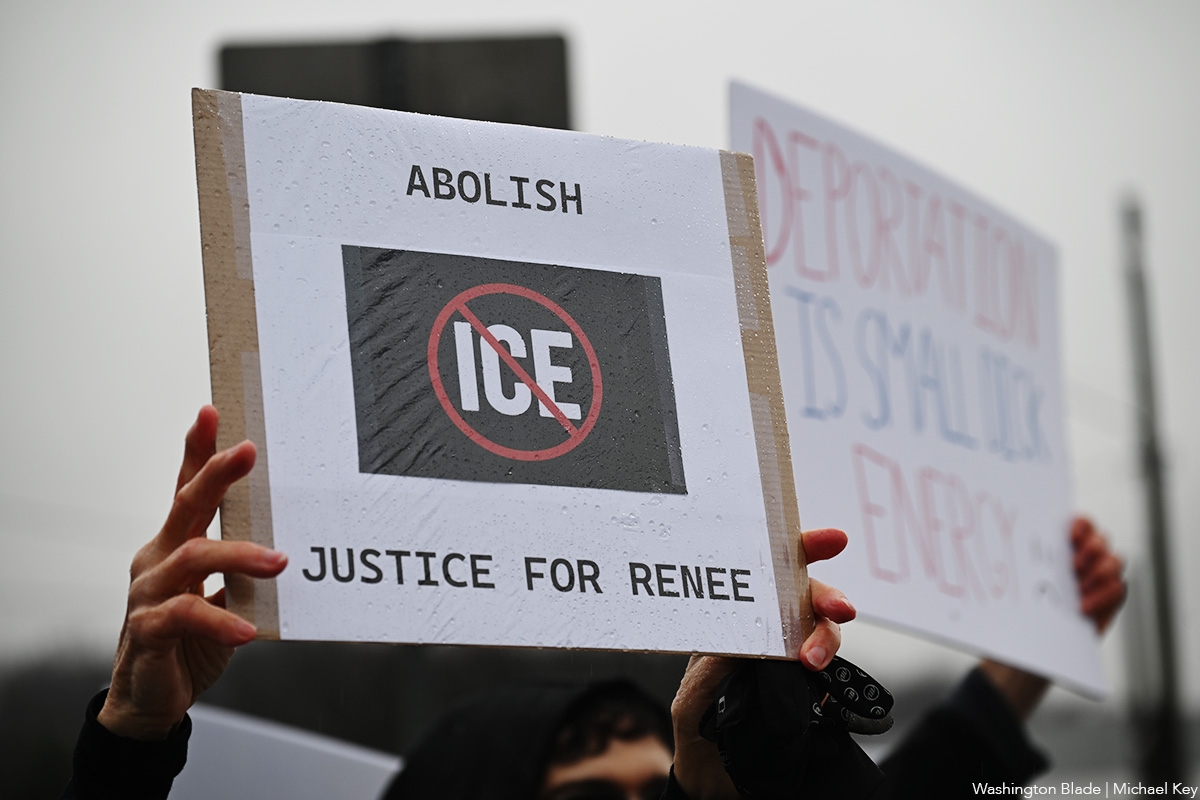
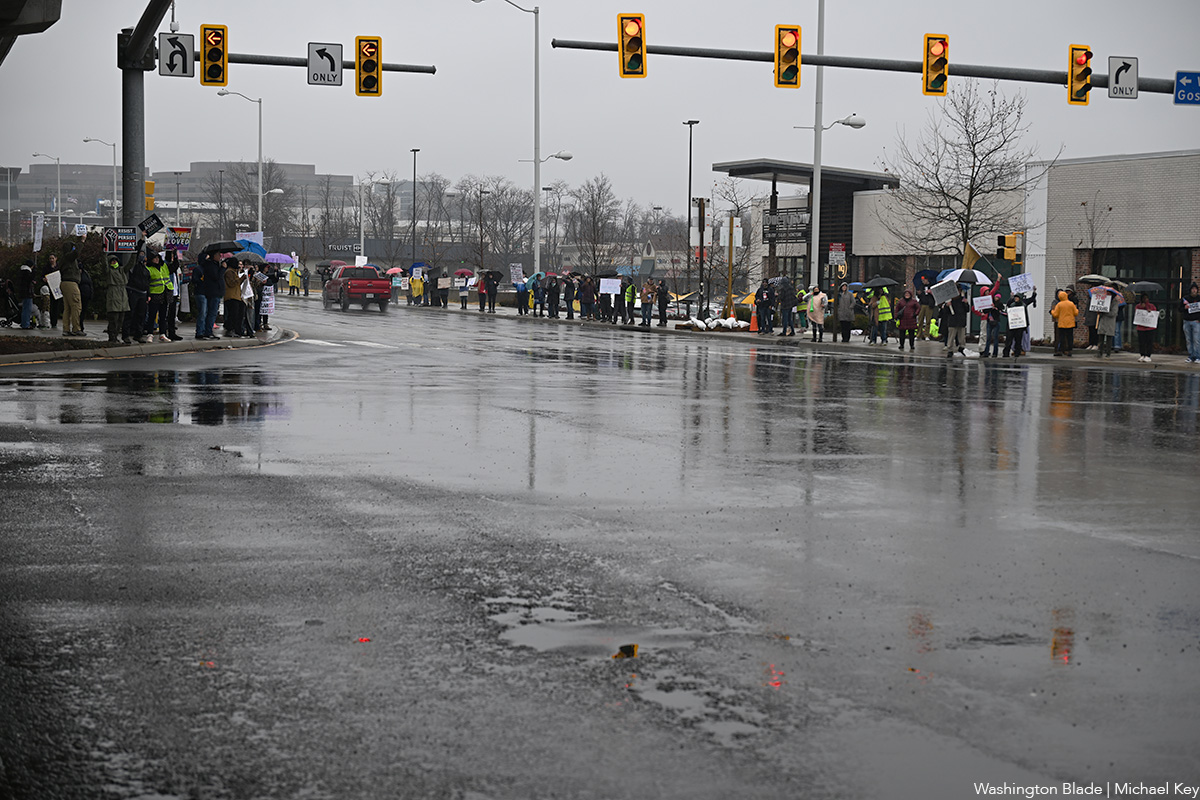
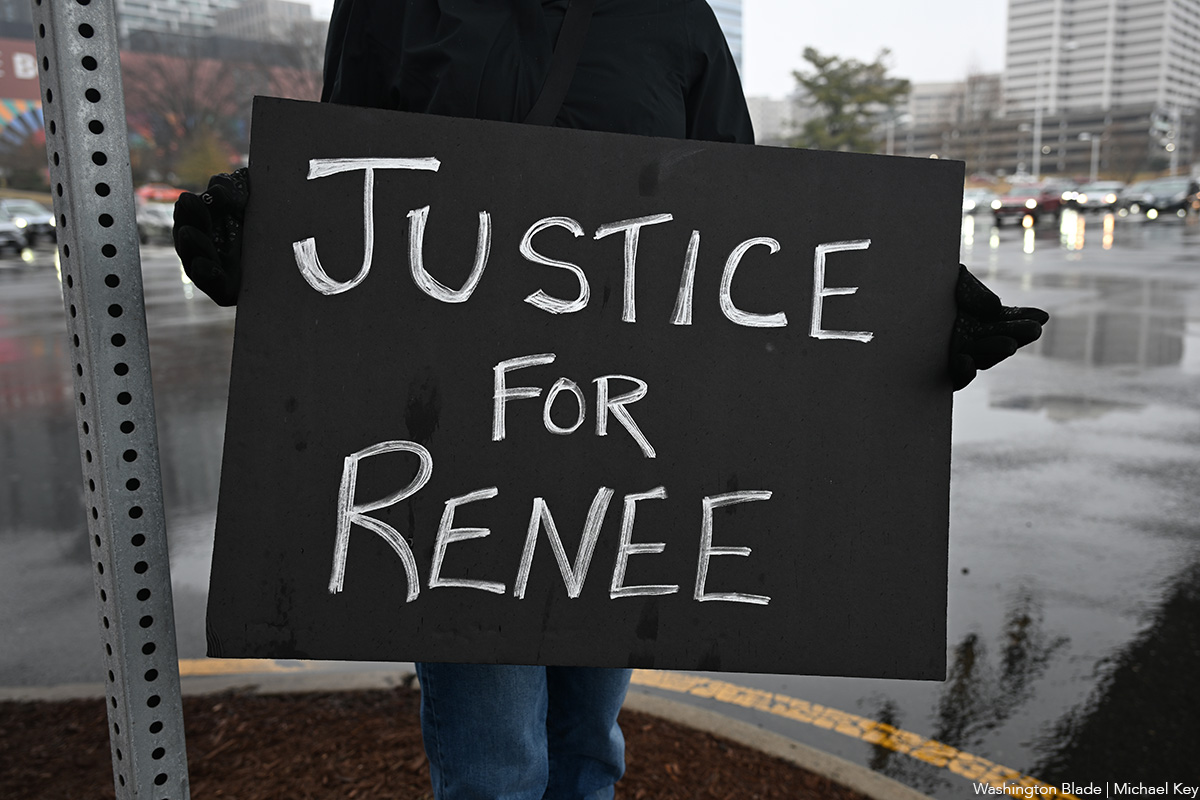
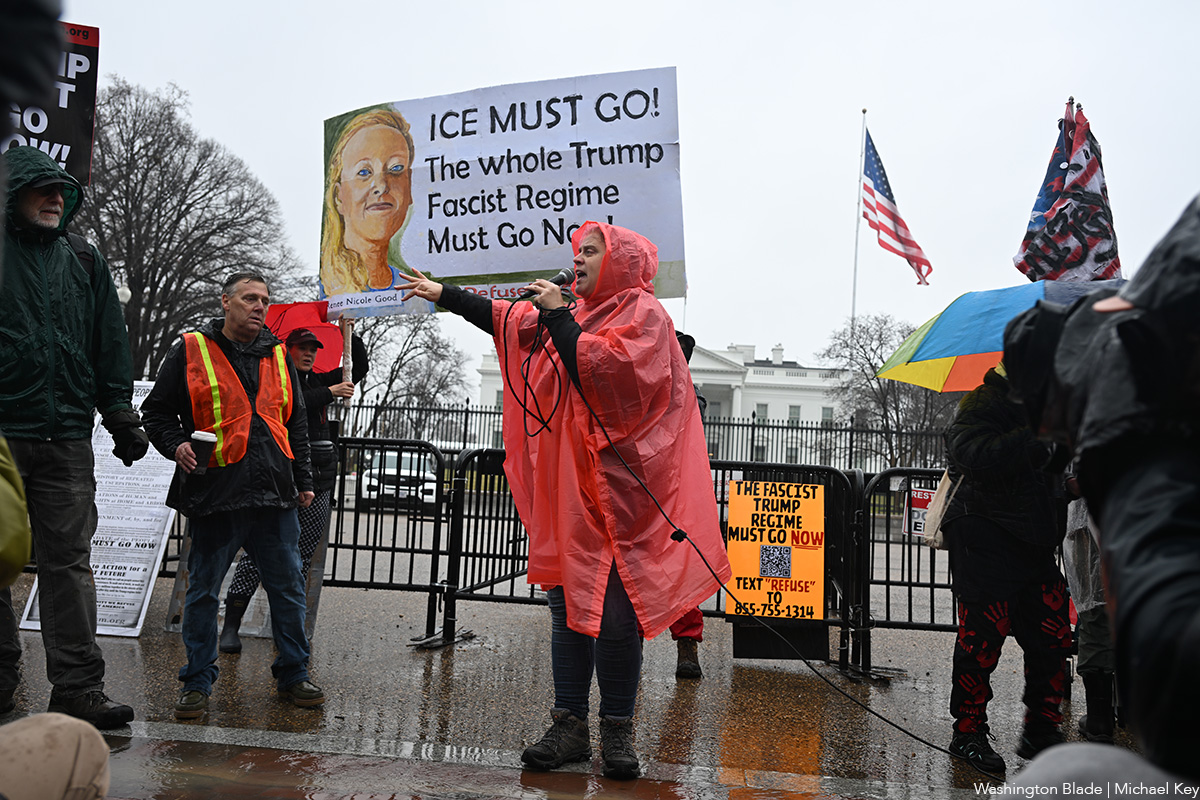

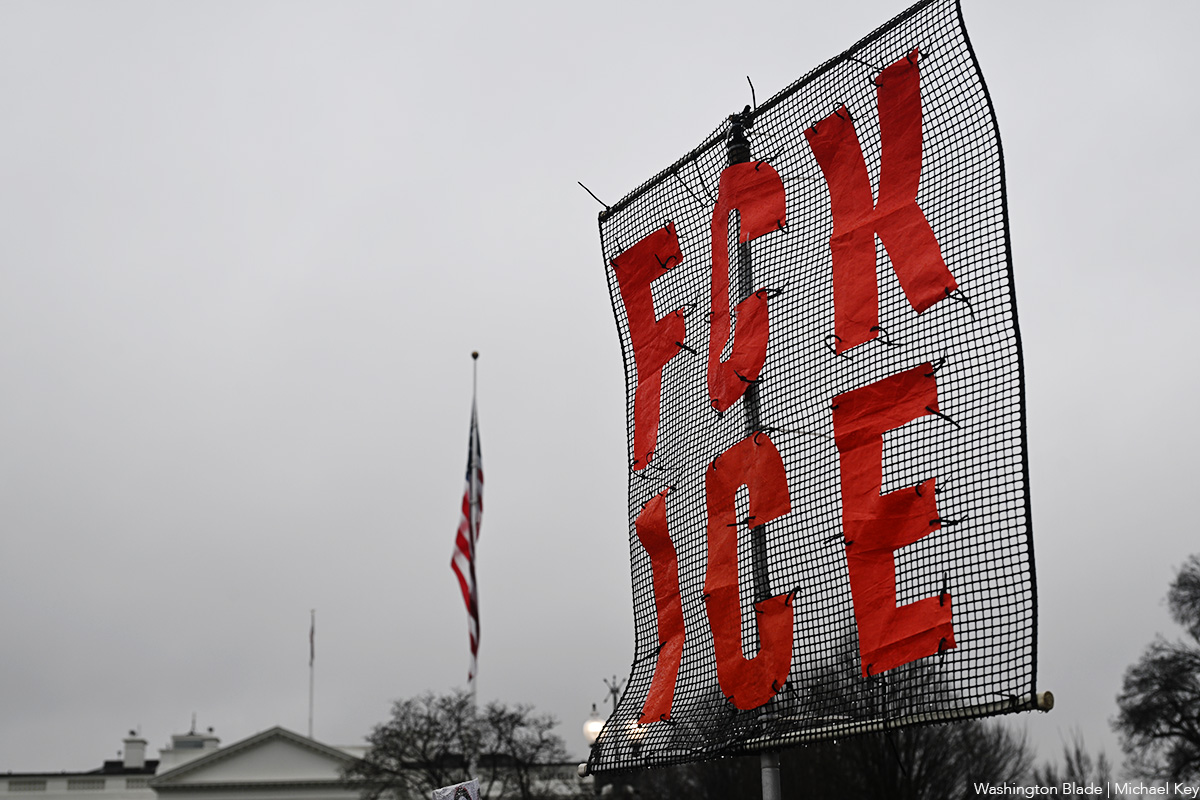

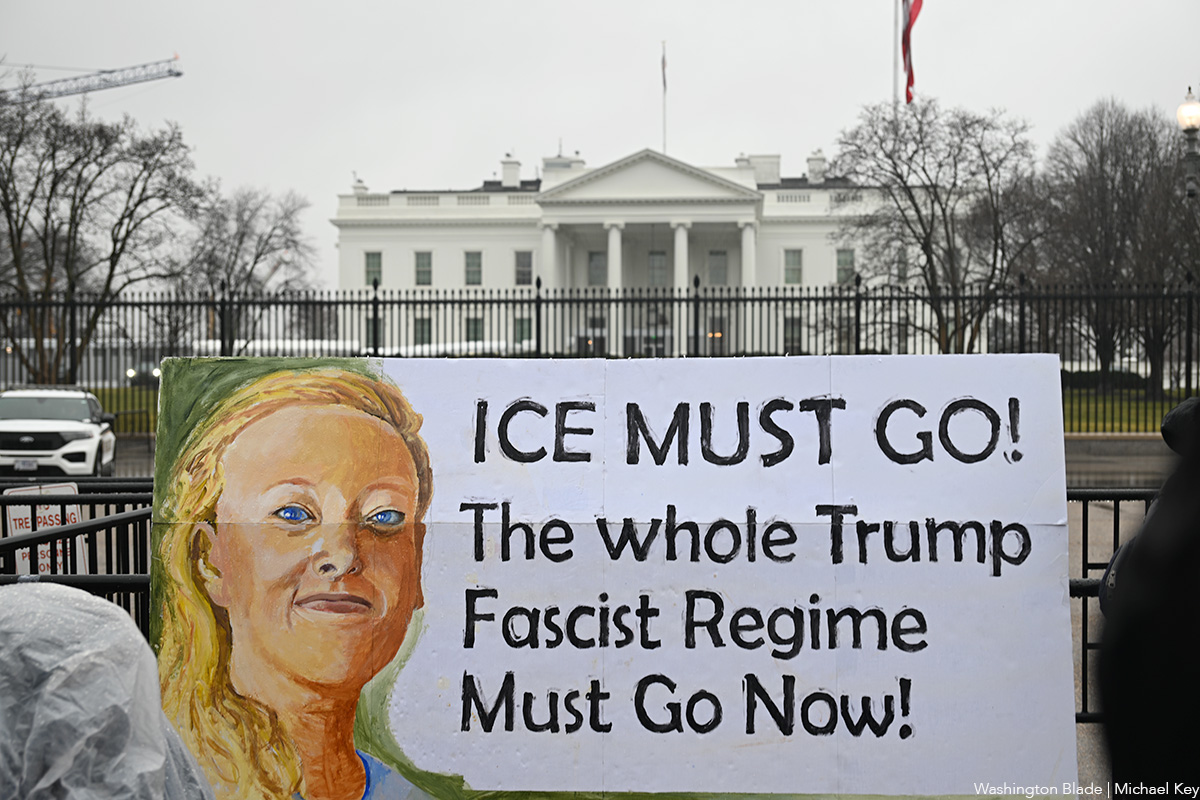
Books
Feminist fiction fans will love ‘Bog Queen’
A wonderful tale of druids, warriors, scheming kings, and a scientist
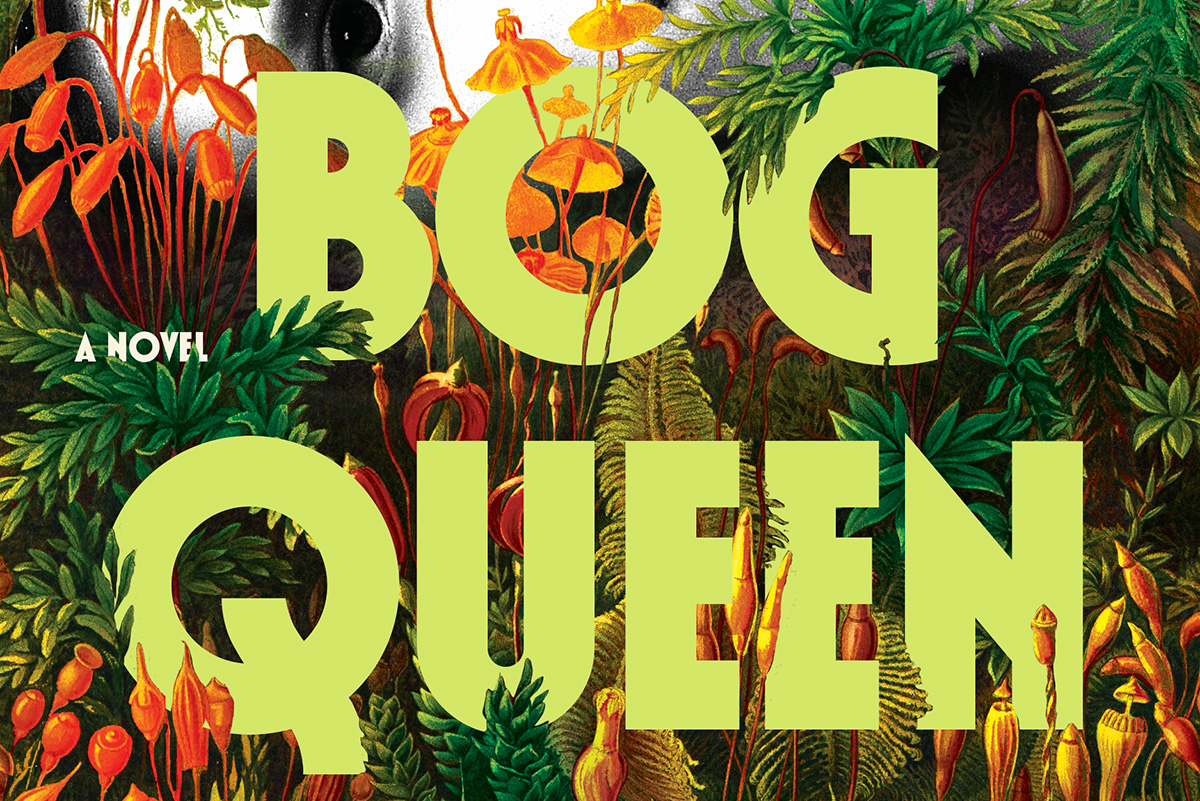
‘Bog Queen’
By Anna North
c.2025, Bloomsbury
$28.99/288 pages
Consider: lost and found.
The first one is miserable – whatever you need or want is gone, maybe for good. The second one can be joyful, a celebration of great relief and a reminder to look in the same spot next time you need that which you first lost. Loss hurts. But as in the new novel, “Bog Queen” by Anna North, discovery isn’t always without pain.

He’d always stuck to the story.
In 1961, or so he claimed, Isabel Navarro argued with her husband, as they had many times. At one point, she stalked out. Done. Gone, but there was always doubt – and now it seemed he’d been lying for decades: when peat cutters discovered the body of a young woman near his home in northwest England, Navarro finally admitted that he’d killed Isabel and dumped her corpse into a bog.
Officials prepared to charge him.
But again, that doubt. The body, as forensic anthropologist Agnes Lundstrom discovered rather quickly, was not that of Isabel. This bog woman had nearly healed wounds and her head showed old skull fractures. Her skin glowed yellow from decaying moss that her body had steeped in. No, the corpse in the bog was not from a half-century ago.
She was roughly 2,000 years old.
But who was the woman from the bog? Knowing more about her would’ve been a nice distraction for Agnes; she’d left America to move to England, left her father and a man she might have loved once, with the hope that her life could be different. She disliked solitude but she felt awkward around people, including the environmental activists, politicians, and others surrounding the discovery of the Iron Age corpse.
Was the woman beloved? Agnes could tell that she’d obviously been well cared-for, and relatively healthy despite the injuries she’d sustained. If there were any artifacts left in the bog, Agnes would have the answers she wanted. If only Isabel’s family, the activists, and authorities could come together and grant her more time.
Fortunately, that’s what you get inside “Bog Queen”: time, spanning from the Iron Age and the story of a young, inexperienced druid who’s hoping to forge ties with a southern kingdom; to 2018, the year in which the modern portion of this book is set.
Yes, you get both.
Yes, you’ll devour them.
Taking parts of a true story, author Anna North spins a wonderful tale of druids, vengeful warriors, scheming kings, and a scientist who’s as much of a genius as she is a nerd. The tale of the two women swings back and forth between chapters and eras, mixed with female strength and twenty-first century concerns. Even better, these perfectly mixed parts are occasionally joined by a third entity that adds a delicious note of darkness, as if whatever happens can be erased in a moment.
Nah, don’t even think about resisting.
If you’re a fan of feminist fiction, science, or novels featuring kings, druids, and Celtic history, don’t wait. “Bog Queen” is your book. Look. You’ll be glad you found it.
Movies
A Shakespearean tragedy comes to life in exquisite ‘Hamnet’
Chloe Zhao’s devastating movie a touchstone for the ages
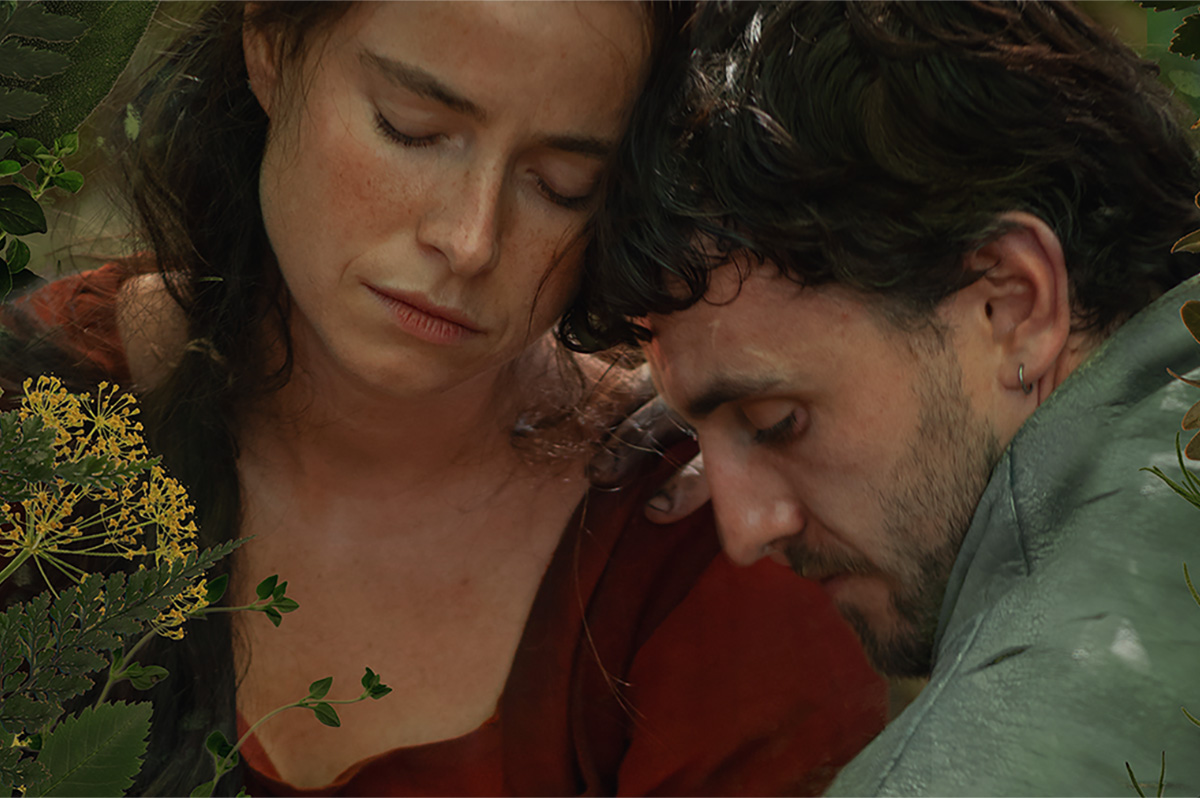
For every person who adores Shakespeare, there are probably a dozen more who wonder why.
We get it; his plays and poems, composed in a past when the predominant worldview was built around beliefs and ideologies that now feel as antiquated as the blend of poetry and prose in which he wrote them, can easily feel tied to social mores that are in direct opposition to our own, often reflecting the classist, sexist, and racist patriarchal dogma that continues to plague our world today. Why, then, should we still be so enthralled with him?
The answer to that question might be more eloquently expressed by Chloe Zhao’s “Hamnet” – now in wide release and already a winner in this year’s barely begun awards season – than through any explanation we could offer.
Adapted from the novel by Maggie O’Farrell (who co-wrote the screenplay with Zhao), it focuses its narrative on the relationship between Will Shakespeare (Paul Mescal) and his wife Agnes Hathaway (Jessie Buckley), who meet when the future playwright – working to pay off a debt for his abusive father – is still just a tutor helping the children of well-to-do families learn Latin. Enamored from afar at first sight, he woos his way into her life, and, convincing both of their families to approve the match (after she becomes pregnant with their first child), becomes her husband. More children follow – including Hamnet (Jacobi Jupe), a “surprise” twin boy to their second daughter – but, recognizing Will’s passion for writing and his frustration at being unable to follow it, Agnes encourages him to travel to London in order to immerse himself in his ambitions.
As the years go by, Agnes – aided by her mother-in-law (Emily Watson) and guided by the nature-centric pagan wisdom of her own deceased mother – raises the children while her husband, miles away, builds a successful career as the city’s most popular playwright. But when an outbreak of bubonic plague results in the death of 11-year-old Hamnet in Will’s absence, an emotional wedge is driven between them – especially when Agnes receives word that her husband’s latest play, titled “Hamlet,” an interchangeable equivalent to the name of their dead son, is about to debut on the London stage.
There is nothing, save the bare details of circumstance around the Shakespeare family, that can be called factual about the narrative told in “Hamnet.” Records of Shakespeare’s private life are sparse and short on context, largely limited to civic notations of fact – birth, marriage, and death announcements, legal documents, and other general records – that leave plenty of space in which to speculate about the personal nuance such mundane details might imply. What is known is that the Shakespeares lost their son, probably to plague, and that “Hamlet” – a play dominated by expressions of grief and existential musings about life and death – was written over the course of the next five years. Shakespearean scholars have filled in the blanks, and it’s hard to argue with their assumptions about the influence young Hamnet’s tragic death likely had over the creation of his father’s masterwork. What human being would not be haunted by such an event, and how could any artist could avoid channeling its impact into their work, not just for a time but for forever after?
In their screenplay, O’Farrell and Zhao imagine an Agnes Shakespeare (most records refer to her as “Anne” but her father’s will uses the name “Agnes”) who stands apart from the conventions of her town, born of a “wild woman” in the woods and raised in ancient traditions of mysticism and nature magic before being adopted into her well-off family, who presents a worthy match and an intellectual equal for the brilliantly passionate creator responsible for some of Western Civilization’s most enduring tales. They imagine a courtship that would have defied the customs of the time and a relationship that feels almost modern, grounded in a love and mutual respect that’s a far cry from most popular notions of what a 16th-century marriage might look like. More than that, they imagine that the devastating loss of a child – even in a time when the mortality rate for children was high – might create a rift between two parents who can only process their grief alone. And despite the fact that almost none of what O’Farrell and Zhao present to us can be seen, at best, as anything other than informed speculation, it all feels devastatingly true.
That’s the quality that “Hamnet” shares with the ever-popular Will Shakespeare; though it takes us into a past that feels as alien to us as if it took place upon a different planet, it evokes a connection to the simple experience of being human, which cuts through the differences in context. Just as the kings, heroes, and fools of Shakespeare’s plays express and embody the same emotional experiences that shape our own mundane modern lives, the film’s portrayal of these two real-life people torn apart by personal tragedy speaks directly to our own shared sense of loss – and it does so with an eloquence that, like Shakespeare’s, emerges from the story to make it feel as palpable as if their grief was our own.
Yes, the writing and direction – each bringing a powerfully feminine “voice” to the story – are key to the emotional impact of “Hamnet,” but it’s the performances of its stars that carry it to us. Mescal, once more proving himself a master at embodying the kind of vulnerable masculine tenderness that’s capable of melting our hearts, gives us an accessible Shakespeare, driven perhaps by a spark of genius yet deeply grounded in the tangible humanity that underscores the “everyman” sensibility that informs the man’s plays. But it’s Buckley’s movie, by a wide margin, and her bold, fierce, and deeply affecting performance gives voice to a powerful grief, a cry against the injustice and cruelty of what we fumblingly call “fate” that resonates deep within us and carries our own grief, over losses we’ve had and losses we know are yet to come, along with her on the journey to catharsis.
That’s the word – “catharsis” – that defines why Shakespeare (and by extension, “Hamnet”) still holds such power over the imagination of our human race all these centuries later. The circumstantial details of his stories, wrapped up in ancient ideologies that still haunt our cultural imagination, fall away in the face of the raw expression of humanity to which his characters give voice. When Hamlet asks “to be or not to be?,” he is not an old-world Danish Prince contemplating revenge against a traitor who murdered his father; he is Shakespeare himself, pondering the essential mystery of life and death, and he is us, too.
Likewise, the Agnes Shakespeare of “Hamnet” (masterfully enacted by Buckley) embodies all our own sorrows – past and future, real and imagined – and connects them to the well of human emotion from which we all must drink; it’s more powerful than we expect, and more cleansing than we imagine, and it makes Zhao’s exquisitely devastating movie into a touchstone for the ages.
We can’t presume to speak for Shakespeare, but we are pretty sure he would be pleased.
-

 National5 days ago
National5 days agoWhat to watch for in 2026: midterms, Supreme Court, and more
-

 Opinions5 days ago
Opinions5 days agoA reminder that Jan. 6 was ‘textbook terrorism’
-

 Colombia5 days ago
Colombia5 days agoClaudia López criticizes Trump over threats against Colombian president
-

 District of Columbia4 days ago
District of Columbia4 days agoImperial Court of Washington drag group has ‘dissolved’

